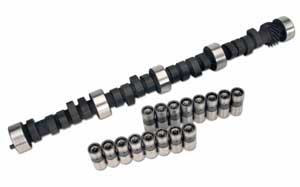For a camshaft to work in a fuel injected application, it needs to make a good vacuum signal.

To create a vacuum signal that stands a reasonable chance at working in an application without having to re-flash the ECM computer, a camshaft needs to be:
A) Short duration, 220-222 degrees at .050˝ maximum.
B) Wide lobe separation/centers, 112 to 114 degrees minimum.
Do not attempt to install a camshaft with a 108 lobe separation in a fuel injected engine, unless you are planning to re-program the ECM computer.
There are camshafts that are ground to work within the stock ECM computer parameters. Usually these camshafts have 208/208 degrees duration at .050˝ (intake/exhaust) and 112 degrees of lobe separation, or 208/214 duration with a 114 L/C.
Both of these camshafts would be designed to function in stock CID engines/stock compression and stock computer programming.
However, if the cubic inches of the engine or compression ratio is larger than stock, the camshaft grind needs to grow accordingly and a custom camshaft would then be in order.
Also, having the computer re-programmed/re-flashed is recommended with any camshaft change, even the “no hassle/safe” type grinds.
While the camshaft may work with the stock fuel/timing curve programmed into the ECM unit, it will not be working at its optimum level. Think of it along the lines of taking a performance carburetor out of the box, bolting it onto the engine, hooking up the fuel lines and running it. It may run but without tuning/jetting the carburetor to the engine, but it will not work to its full potential.
While we are on this subject, there are some engines that you need to be wary of:
• Late ’80s-Early ‘90s 350 Chevrolets with a K engine code and an idle speed of 500 rpm (TBI)
• Early Ford V8s with the Speed Density fuel injection
• Dodge Magnum V8s
• Any fuel injected application where the customer wants a loud/radical idle
These engines/computer combinations have very special camshaft grind requirements, so should you run into one of these combinations, it would be best to call your camshaft manufacturer for a recommendation.
Tech Tip courtesy of PBM-Erson Cams.













